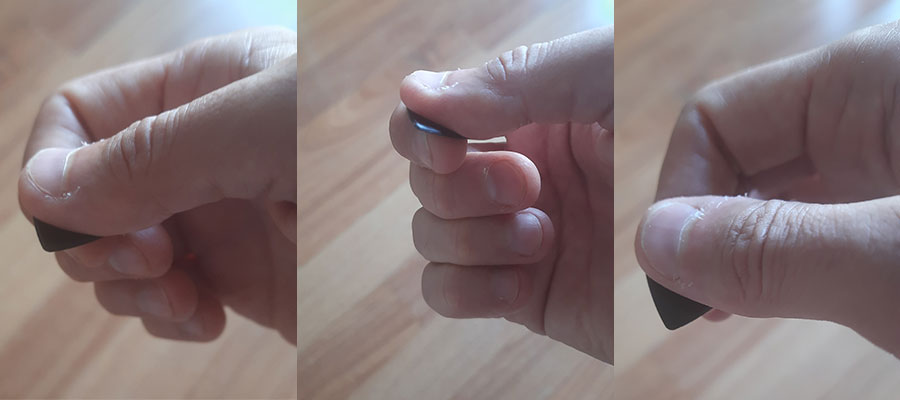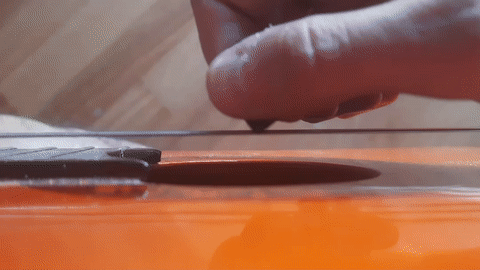How to Hold a Guitar Pick
Beginner Guitar Basics
When a student is new to the guitar, even seemingly trivial things can be confusing.
Many players initially strum with their fingers, as it is easier and allows you to touch the strings.
Eventually though you will want a pick for better accuracy and even a louder sound.
In this article we will go over the basics on how to hold a guitar pick.

The Plectrum
The word "plectrum" is the proper term for a pick, the former often used in a more formal setting.
Except for the harpsichord (which picks the strings instead of a normal piano hammer-on), the pick is usually held in the hand. Most instruments that use a regular pick will be in the lute and guitar families.
Banjo and autoharp players often use metal finger picks that stay on, allow better accuracy, and produce a louder volume. Lap steel, dobro, and even acoustic guitarists will also use a similar finger type pick for these same reasons.
Mostly though you will be using flat picks to play guitar.
These are usually made of plastics, but also come in metal, celluloid, and even exotic materials from animals.
But beware as the latter is often illegal. (Besides, tortoise shell picks and animal bone guitar nuts really don't sound any better than modern materials.)
How to Hold the Guitar Pick
You will want to use a thin pick at first, as it is more flexible and will allow you to make easier sweeps across the string.
Don't worry about picking individual strings until you are better at holding the pick. Initially stick to long up and down strums, after you get a smooth movement in your wrist, you can start on individual strings.

Finger Placement
Sitting with your guitar, take a regular flat pick and place it between the top of the thumb and first finger.
Relax your other three fingers, as you do not want a tight grip, but don't loosen them too much or they will flop around as you strum.
You don't want the pointy end of the pick sticking up, but inward towards the guitar strings.
There should be at least 1 cm of the tip exposed, as you get better you can get closer to holding the tip for accuracy.
After you have rotated the pick inward, the thumb and first finger are now almost perpendicular to each other.
And the pick is now more on the side of the first finger. This will allow a better grip than with the front of the finger.
If you pick too hard it can affect the intonation, this means the notes will not sound properly tuned.
Start out hitting the strings lightly, only get louder as you improve.
The Grip
Watch bumping the strings with your fingers or thumb as this will unintentionally mute them.
As you strum you will know if your grip is too tight or loose. If the pick moves or spins between the thumb and finger, then you need to squeeze a little harder.

If you are playing too loud or your hand starts to hurt too soon, then your grip is way too tight.
It's not easy to teach the specific grip to a student as they really must try out picking before we can adjust.
Your goal is to find the right pressure, so you don't drop it, or play bad.
Some players may let their other three fingers hang out a little (it helps loosen up and to grab the whammy bar fast).
If you want to tuck them in more, just avoid going too far and making them into a fist.
When you first start practicing, your pick practice goes hand in hand with learning chords.
While you are learning chords, you need to strum every string to be sure the chord is being played correctly. This is a great time to practice hitting every string with your pick as you work on chords!
If this is your first time using a pick you will see how much easier strumming is when using one. Playing with just fingers is fine for some genres, but if you really want the most out of the guitar, then the pick is essential.

What Does Thickness and Materials Matter?
If you start playing with a thin pick you should have an easier time as a beginner.
A thinner pick (like .50-.70 mm) will be easier to play, but it will also "click" as you strum and make it hard to hit specific strings. If you go too high in thickness (over 1.5 mm) it will be more like using a coin!
There are also a variety of shapes used like teardrop, triangle, and beveled edges.
Sometimes they are tiny (like jazz picks) or big and fat, there really is a huge assortment of lengths and widths. The shape usually matters more for comfort and accuracy as opposed to the sound.
But the material used can drastically alter the final sound. We mentioned plastics and metal above, but we didn't dive too deep.
The metal you use will make a difference, and there are tons of plastics these days, some that have different sound qualities. Materials with different textures will also matter when gripping the pick.
The best thing to do is start trying different shapes, sizes, and textures.
Experiment with a variety of materials, take note of the difference in sound. Sometimes it is subtle, other times a huge change! If you keep a proper grip and can accurately hit your notes, you will be able to play with any type of pick.
And, if you start playing the guitar a lot and stick with it you will likely go through a lot of picks.
Eventually you may even want to spend a little more on a nicer one, which is fine. Picks and strings are very important to our final sound, so it's best to experiment with a variety!
To proceed in your learning journey, have a look at our guitar lessons and don't forget to subscribe for updates.